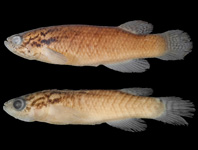Abstract
The previously unknown male of Aplochares imitator (Smith), the type species of the genus, is associated with the female and described. Aplochares imitator provides another case of dual sex-limited mimicry. The coloration of the male of A. imitator is similar to that of both sexes of A. adrastes Banks, while the coloration of the female of A. imitator matches that of several species of other unrelated Hymenoptera. A key to both sexes of Aplochares is provided along with illustrations of the two species.
References
Ashmead, W. (1902) Classification of the fossorial, predaceous and parasitic wasps of the superfamily Vespoidea. Part 4. Canadian Entomologist, 34, 79–88.
https://doi.org/10.4039/Ent3479-4Banks, N. (1939) Notes and descriptions of native Psammocharidae. Canadian Entomologist, 71, 225–231.
https://doi.org/10.4039/Ent71225-11Banks, N. (1944) The Psammocharidae (Hymenoptera) taken at Kartabo and other localities in British Guiana. Zoologica: New York Zoological Society, 29, 97–112.
Banks, N. (1947) Studies of South America Psammocharidae, Part II. Bulletin of the Museum of Comparative Zoology, 99, 369–486.
Dufour, L. (1834) Observation sur une nouvelle espèce d’Anoplius quin’offre qu’un seule ocelli. Annales de la Société entomologique de France, 2, 483–485.
Evans, H.E. (1966) A revision of the Mexican and Central American spider wasps of the subfamily Pompilinae (Hymenoptera: Pompilidae). Memoirs of the American Entomological Society, 20, 1–442.
Evans, H.E. (1968) Studies on Neotropical Pompilidae (Hymenoptera) IV. Examples of dual sex-limited mimicry in Chirodamus. Psyche, 75, 1–22.
https://doi.org/10.1155/1968/76089Smith, F. (1864) Descriptions of new species of Brazilian Pompilidae. Journal of Entomology, 2, 263–270.
Wilson, J.S., Jahner, J.P., Forester, M.L., Sheehan, E.S., Williams, K.A. & Pitts, J.P. (2015) North American velvet ants form one of the world’s largest known Müllerian mimicry complexes. Current Biology, 25 (16), pp. 704–706.
https://doi.org/10.1016/j.cub.2015.06.053

